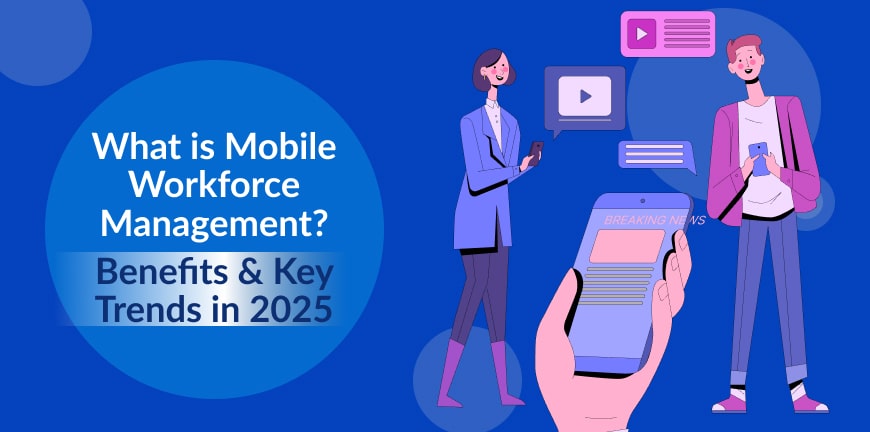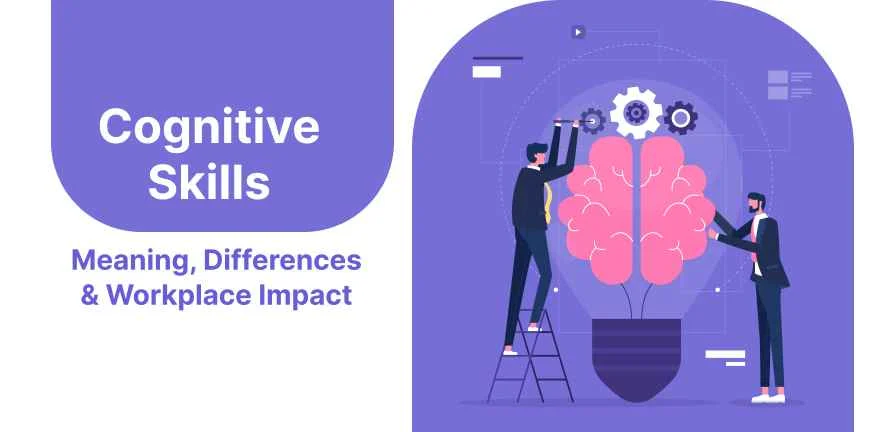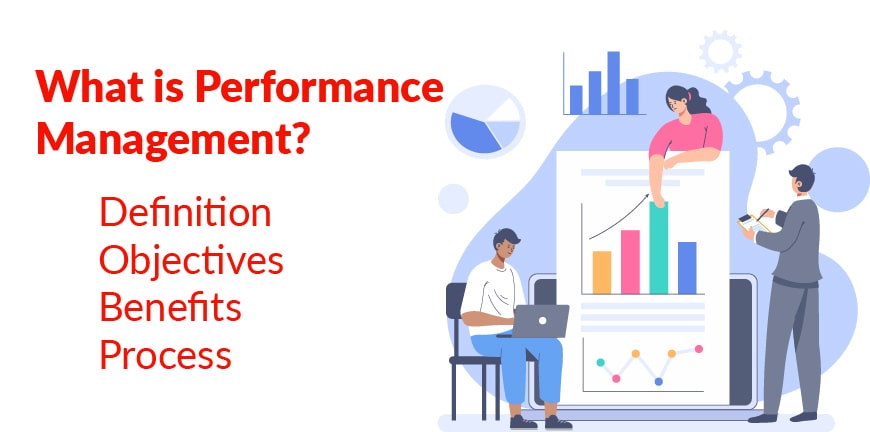
What Is Payroll Tax Compliance? Benefits, Key Components, Best Practices
22/04/2025
Bridging the Gap: How is India Addressing Skills Shortages?
23/04/2025- What is Mobile Workforce Management? Meaning & Definition
- How is Mobile Workforce Management used in Businesses?
- What are the benefits of Mobile Workforce Management Solutions?
- What are the Key Features of Mobile Workforce Management?
- What are the Future Trends in Mobile Workforce Management?
- What are the Challenges and Limitations of Mobile Workforce Management?
- Frequently Asked Questions (FAQs)
In a world that has transformed the workforce into functioning across time zones, streamlining, scheduling, tracking performance in real time and keeping everyone connected is the need of the hour. It is not about just managing individuals but also about empowering them to perform from any part of the world.
What is Mobile Workforce Management? Meaning & Definition
Mobile workforce management means defines a method of coordinating, assisting and monitoring employees who are working outside the preview of traditional office environments. Mobile Workforce Management (MWM) software and other technologies re used to streamline the operations, enhance efficiency and accelerate customer satisfaction.
How is Mobile Workforce Management used in Businesses?
A Mobile Workforce Management strategy enables businesses to support and manage employees who work outside a central office effectively and efficiently. The system leverages tools and technologies to perform tasks like scheduling, communication and tracking. The remote teams and filed service operations especially benefit from this approach as they facilitate real-time monitoring and communication.
What are the benefits of Mobile Workforce Management Solutions?
There are several benefits of Mobile Workforce Management. MWM solutions help in streamlining, scheduling, dispatching and facilitating transparent communication. This results in fewer inefficiencies and better performance. Let us look at some of the key benefits:
1. Enhanced Productivity
MWM plays a vital role in reshaping the way organizations manage their field and remote teams. These solutions automate key processes, minimizing delays and drive employees to focus on core strategic work, fostering greater productivity and accelerated quality of output.
2. Improved Communication
Real time communication tools have become integral to businesses today with widely scattered and mobile work environments. It is useful to keep teams aligned, connected, and productive. There is a constant flow of information between remote employees and managers bridging the gap resulting in accelerated decision making and collaboration.
3. Accelerated Flexibility
In today’s fluctuating business environment and a rapidly evolving world flexibility has become a necessity. Mobile Workforce planning enables companies to grow with agility. MWM solutions allow employees to work from virtually anywhere while providing businesses with the accurate tools to adapt and cater to the changing needs.
4. Cost Savings
In a competitive and cost-conscious business landscape, Mobile Workforce Management (MWM) has surfaced as an impactful tool enhancing operational efficiency. By streamlining resource use, optimizing schedules and reducing travel time, MWM proves to be very cost-effective maintaining service quality or productivity.
5. Sustainability
Organizations today are increasingly focusing on reducing the carbon footprint and operate sustainably to not just cater to regulatory demands but also align with customer values and meeting long-term business goals. MWM plays a significant role in contributing towards sustainability by optimizing routing and minimizing unnecessary travel.
What are the Key Features of Mobile Workforce Management?
Mobile Workforce Management (MWM) solutions are crafted to enable businesses to manage employees working outside a traditional office set up. Along with vital features MWM often integrates features like time tracking and reporting with other business systems. Now let us check out a few of the key features:
1. Real-time Tracking
MWM uses GPS tracking technology enabling managers to monitor and keep track of the location of mobile employees in real time. There are real-time communication tools available for instant communication between managers and remote workers driving quick responses and adjustments.
2. Scheduling and Task Management
Automated scheduling is a feature enabling the drafting and management of schedules for mobile employees, considering elements like skills, location, and availability. Another important feature is task assignment and prioritization helping managers to assign tasks to the right employees, track progress and adhere to priorities as required.
3. Time Tracking and Reporting
Digital time tracking is a significant feature that offers accurate and efficient time tracking for mobile employees. Reporting and analytics also provide real-time reporting on the performances of each employee. It can schedule adherence and other key metrics facilitating data-driven decision-making.
4. Integration and System Compatibility
CRM Integration is another vital MWM feature that enables seamless integration with Customer Relationship Management (CRM) systems allowing mobile employees to access customer data. Then there is HR and payroll integration facilitating seamless integration with Human Resources (HR) and payroll systems, streamlining processes and alleviating administrative overhead.
What are the Future Trends in Mobile Workforce Management?
Mobile workforce solutions are evolving rapidly, and it becomes essential that we are aware and well informed about emerging mobile workforce trends that can accelerate employees’ and customer experiences. Here are five mobile workforce trends shaping the future of mobile workforces:
1. Enhanced Connectivity
MWM platforms offer smooth communication and collaboration capabilities, regardless of location. The recent global rollout of 5G networks has been advantageous for mobile workers as it enables smoother communication and seamless data transfer from any location. Workforce management systems often integrate vital mobile workforce tools for communication and collaboration.
2. Virtual Reality
Organizations are rapidly adopting augmented and virtual reality to enhance training and job performance for mobile employees. Augmented Reality is being utilized to provide detailed schematics on specific equipment or job sites and Virtual Reality enables retailers to preview store remodels before construction. Individuals who work as technicians can practice complex tasks in a virtual environment, honing their skills prior to operating real-world equipment.
3. Ai Power
In today’s Ai powered world innovative businesses utilize AI mobile workforce solutions for mobile teams for scheduling, routing, and resource allocation. Machine learning algorithms will assess data to predict workforce requirements, optimize resource allocation, and enhance decision-making. AI provides tailored communication and assistance for each mobile employee, accelerating engagement and satisfaction.
4. Robust Security
Today data protection is the need of the hour and Mobile workforce management systems implement sturdy security measures to safeguard sensitive data, ensuring compliance and trust. To prevent data breaches, Mobile device management (MDM) solutions are utilized to control and secure mobile devices used by employees.
5. Cloud Collaboration
Mobile teams distributed across locations require reliable connectivity regardless of where they are. Cloud-based platforms are impactful collaboration centers facilitating video conferencing, large file sharing and joint project management from any device, ensuring enhanced productivity for mobile teams.
What are the Challenges and Limitations of Mobile Workforce Management?
Managing a mobile workforce is not devoid of challenges. Let us look at the challenges so that companies can overcome them and shape the future of mobile workforce:
1. Communication
Mobile workers can sometimes face difficulties in communicating and collaborating effectively with colleagues, especially when they are scattered across and rely totally on technology for communication.
2. Security
Excessive use of mobile devices and access to sensitive data presents security risks, if not addressed through robust security measures can be hazardous. Measures include encryption, multi-factor authentication, and regular security audits.
3. Employee Engagement
There can be a sense of disconnect and isolation in employees who are mobile workers due to lack of physical interaction impacting their morale, personal and professional growth.
Technology Adoption and Training:
Sometimes implementing new technologies and training employees to use them effectively might take time to work as it is beyond installing software or hardware. It requires a comprehensive strategy encompassing both the technical and human aspects of the transition.
Compliance:
There is an array of rules, regulations and laws mobile workforces must comply with bringing about complex challenges. From labor laws, health and safety regulations to data privacy and security compliance. The workforce needs to be well aware and trained to adhere to them.
Mobile workforce management meaning is well defined when the system is effectively implemented, leveraging mobile workforce management software, optimizing scheduling, and ensuring efficient data management practices. Let us check out some of the important practices:
4. Communication and Training
Employees must comprehend how the software will affect their work, entailing key performance indicators and mandatory features. Companies need to ensure that employees have substantial training materials to facilitate effective learning.
5. Security and Policy
A mobile device management (MDM) policy should be implemented by organizations defining how devices are deployed, access to the corporate network and user permissions. They need to educate employees on security protocols and best practices, like password management and data protection,
6. Workforce Management Software
Workforce management software needs to be leveraged to streamline scheduling, forecasting along with performance tracking. Organizations should efficiently distribute staff to ensure the right tasks are delegated to the right people at the right time,
Frequently Asked Questions (FAQs)
1. What is the meaning of MWM?
MWM or Mobile Workforce Management refers to solutions and services used to manage employees working outside of a traditional office set up.
2. What is a mobile workforce?
Mobile workforce is a group of workers working outside of a traditional office environment using mobile technology to work and connect remotely.
3. How Is mobile technology altering workplace communication?
Mobile technology is essentially reshaping workplace communication by fostering quicker processes, more flexibility and establishing diverse interaction modes.
4. What is labour force management?
Labour force management is workforce management which entails a comprehensive set of processes and tools used to refine employee productivity,
5. How important is workforce management?
Workforce management (WFM) is extremely significant as it directly affects a firm’s productivity, profitability, and employee satisfaction.
Contact Us For Business Enquiry

Rajkumar Shanmugam
Rajkumar Shanmugam is the Head of HR at ALP Consulting, bringing over 19 years of comprehensive HR leadership experience across India and international markets. His expertise spans talent acquisition, employee relations, performance management, compliance, and HR transformation. Rajkumar has a proven track record of driving people-centric initiatives, enhancing workplace culture, and aligning HR strategy with business goals. With extensive experience in US staffing operations and global mobility, he continues to lead organizational excellence through innovation and employee engagement.




